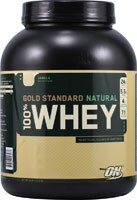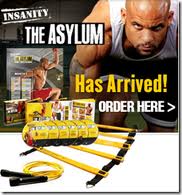This is Part 4. You can read Part 1 here, Part 2 here, and Part 3 here.
RULE #12: ADJUSTABLE DUMBBELLS ARE GREAT.
When I was preparing to start P90X, I didn’t even know about adjustable dumbbells, nor was I aware that regular dumbbells cost so frickin’ much!
I was torn, because either way I was going to be shelling out a few hundred bucks. I was going to be working out in my living room, though, and the space saving nature of adjustables came into play.
Still torn, I walked into my Costco just to have a look, and I found some great adjustables for only $300, including stand. They don’t have them at Costco anymore, and they are a bit more than $300 now, but they are called Ironman Leverlock Adjustable Dumbbells, and they have been great. (Great, that is, as long as you ensure the levers are indeed locked before you pick them up. You should do that anyway, but I’m just sayin’, because I remember reading bad reviews about these things, probably from people who did not bother to check the locks.)
I did an online search and I see these things are available at Sears and Kmart, so check ’em out. Here’s a link so you know what they look like. They come with the stand, which is great, because when you are picking up a dumbbell, it sure is nice not to have to go all the way to the floor to get it.
And, yes, in case you are wondering, I found the 55 pounds per side to be more than enough for my current strength level.
Another thing to keep in mind is the ability to adjust throughout the set at 2.5-pound increments. I found that to be useful. Adjusting in 5-pound increments would have been too much. Stepping up from 15 to 17.5 to 20 pounds works very well.
As I said, I’ve heard great things about the Bowflex ones, and they have come down in price, so here’s a link to them, if you want to check them out. I’m sure others have hit the market in the couple years since I’ve shopped for them, so shop around.
RULE #13: USE A HEART RATE MONITOR.
P90XÂ is an extreme exercise program, so you should get a checkup from your doctor before you start it. Did I do that? No. But I should have, I guess.
What I did do, though, was get a heart rate monitor and use it to decide when to slow down. Those first few weeks of Plyo and other aerobic/anaerobic activities will send your heart rate through the roof, if you are not in top shape, so the heart rate monitor made it easy for me to gauge my exertion level.
To figure out your max heart rate, just subtract your age from 220. If you are 50-years-old, your max heart rate is is 170, so I figured about 80% of that as an initial target. 170 * 0.8 = 136. I rounded to 140 and kept an eye on that. Once my heart rate went over 140, I slowed down a bit, then picked it back up to try to stay in the 130-140 range. After a while I raised that high target to 150, and after another while I stopped using the heart rate monitor altogether. But it was a valuable tool at the beginning to keep me informed about how hard my heart was working, because it was often beating much harder than I realized.
There are many models out there, but I wanted to go cheap, so I went with this one from Omron, and it’s served me very well.
ADDED SEPTEMBER 2, 2012: When my Omron gave out, I bought a Polar. I like it better than the Omron. It’s better constructed and easier to wear, but, of course, it’s a lot more expensive. Check it out here.
RULE #14: IF YOU FIND PULLUPS TO BE VERY DIFFICULT-TO-IMPOSSIBLE, TRY AN ALTERNATIVE.
Pullups are hard for most people, because we just don’t use our backs that much. Of course, that is the root of many of our back problems, so pullups are important to work through, even if you can’t do more than one right now.
During P90X, Tony offers a couple of alternatives to pullups.
The first pullup alternative involves using a chair to assist with the pullup.
I tried this. It was problematic for two reasons:
- The chair would slip often on my tile floor, and
- I found myself using the chair and my legs far too much.
I don’t recommend chair-assisted pullups, but please give it a shot, so you can decide for yourself.
The second pullup alternative Tony recommends is using a resistance band. So you attach the resistance band to something above you, then from your knees or your butt, pull the band down toward your chest, arms spread, in a pullup motion.
I tried this, too. It was better than chair-assisted, but was problematic for three reasons:
- It was a pain in the butt to get the band looped around my pullup bar so it would provide enough resistance to make the exercise worthwhile,
- You really need a heavy-duty band to get enough resistance, and I didn’t have that, and
- I pulled the pullup bar down on top of myself one time doing this.
Again, you may want to try this — maybe you’ll love it — and I used it for a long time, actually, before coming up with what I do now.
The third pullup alternative is one I came up with myself, and I think it works great. It’s this — DO PULLUPS! Okay, that’s not really an alternative to pullups, but the methodology is different than what goes on in the program. When it’s time to do pullups, you simply set a timer — I use our kitchen timer — for one minute, and do as many pullups as possible in that one minute. Take all the breaks you need during that minute, but always keep working to get one more pullup until the timer goes off.
You may need to pause the DVD while you do your minute, but it’s worth the small hassle, because the only way to get better at pullups is to do pullups. Do as many as you can in a minute.
ADDED AUGUST 22, 2012: There is yet another way to do pullups now, and it is with the Beachbody Chin-Up Max. It hooks over your pullup bar, you slip your foot into it, and you get pullup assistance. The Chin-Up Max is adjustable, so you can get just as much assistance as you like. Check it out here.
RULE #15: BE SAFE
Safety is very important when you are engaging in any kind of physical activity, not only because you need to understand the limitations of your body, but you need to also, if the activity is new, be aware of any issues you may not already know about.
When you are in program like P90X, a program that is designed to get you into better shape, it’s natural for you to want to overwork. You’re feeling good. Surely you can lift more weight than that. And. Then. Uh oh. Down for the count.
But you already know that, so here are a few safety tips you may not be as aware of.
Keep your core tight. Tony does not mention this much in P90X. Shaun T harps on it, though, in Insanity, and it’s really important, not only because it helps build your abs, but also because it keeps your back safe. If you just keep those abs at least somewhat engaged, no matter what you are doing, you’ll notice the difference in performance, balance, and muscle tone.
Lift and replace the dumbbells gently. This just means that you need to not yank at the dumbbells when you pick them up and you should place them back carefully. In other words, stay in control. There are some exercises that are exceptions to the “placing them back carefully” rule — sometimes you have to just let them drop, but the key is to not hurt yourself. Yanking at them when picking them up can strain your arms, shoulders, and back, while dropping them can damage your feet and toes, when the dumbbell bounces from the floor onto them. Trust me, this one I learned from experience.
Watch out for equipment and furniture. Really, this is a no-brainer, but those are the ones that get you. Don’t be lazy about putting dumbbells back, because, sure enough, at some point you’ll stub your toe and that can put you out of commission for the day. If you work out in your living room, coffee tables, also, can be dangerous, especially once you lose that layer of fat you have on your shins. You may not know it’s there, but, believe me, when you hit your fat-free shin on the coffee table, if you catch it just wrong, it’ll bleed like a sumbitch, and leave a permanent scar, too. Been there, done that.
Make sure your pullup bar is secure. Many of those over-the-doorframe pullup bars have little clip to help keep them in place. Use it. This is especially important if you are wrapping exercise bands around the pullup bar to do band pullups from the floor, because that can cause the pressure on the bar to be different from the manufacturer’s design, and…. Okay, yeah, been there, done that, too. Mine doesn’t have the clip to hold it in place, but I am much more careful with it these days.
And that about wraps up this 4-part series. I’m sure I didn’t cover everything, but this should be enough to get you started.


